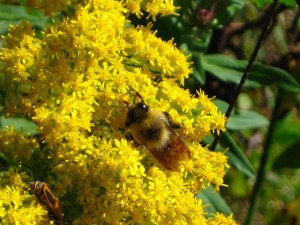by Shawn Radcliffe, CYT and writer
Regularly practicing the yoga breathing technique called bhramari may help you relieve stress, sleep better and reduce sinus infections or thyroid problems.
If you have ever listened to chanting in a church or a high-ceilinged yoga studio — or curled up next to a purring cat — you know how powerful sound vibrations can be.
Humming bee breath, known as bhramari pranayama, harnesses the power of sound to bring you more calmness and clarity. You will even feel these effects long after your yoga practice has ended.
Benefits of Humming Bee Breath
 Bhramari pranayama is safe and easy to learn. It is also sometimes used as therapy for many conditions, including:
Bhramari pranayama is safe and easy to learn. It is also sometimes used as therapy for many conditions, including:
- insomnia
- thyroid problems
- sinus infections
- stress
As always, if you have a serious medical condition, check with your doctor before starting any new yoga practice. You will also benefit from working directly with a qualified yoga teacher.
Like other types of yoga breathing exercises, the benefits of humming bee breath comes from extending the length of your exhale compared to your inhale.
This tones down your fight-or-flight response (sympathetic nervous system) and activates your body’s built-in stress release (parasympathetic nervous system).
You will also benefit during humming bee breath by covering your eyes and ears with your fingers (shanmukhi mudra). This blocks out the external world and allows you to focus on bhramari’s buzzing sound — instead of the constant chatter in your mind.
How to Do Humming Bee Breath
1. Sit on your heels with your knees and ankles together and the tops of your feet on the mat (vajrasana or Adamantine Pose).
2. With your elbows at shoulder level, place your hands on your face in shanmukhi mudra:
- One thumb placed in each ear, either directly in opening of the ear canal or bending in gently the ear tragus (the flap of skin at the opening of the ear)
- Index and middle fingers placed over your closed eyelids (using a very light pressure)
- Ring fingers placed alongside your nostril (you can use your fingers to control the amount of air flowing in and out of the nostrils)
- Pinky fingers placed at the corners of your closed mouth
3. Inhale for a count of six.
4. As you exhale through the nose, make a buzzing sound in the nasal passages, like the high-pitched sound of a bee. Exhale until you need to inhale again, without straining.
5. Repeat three to nine rounds of inhales and exhales.
6. Release your hands to your thighs or knees. Keep your eyes closed.
7. Rest in this position for a few minutes.
Variations
- Sitting position: Choose a position that allows you to focus on your breathing. If it is difficult to sit on your heels comfortably, you can also sit on a block placed between your feet. Or try sitting cross-legged (on a blanket if your hips or lower back are tight) or on a chair.
- Hand position: If you find it difficult to keep your hands on your face throughout this breathing exercise, you can also do humming bee breath with your hands on your lap. Keep your eyes closed to block out the external world.
- Pitch of buzzing: Try buzzing at different pitches, from low to high, to see which gives you the most effect.
- Breathing: If inhaling for a count of six is too long, try a count of three of four. Whichever you choose, focus on making the exhale longer than the inhale.
About Shawn
I am a freelance health and science writer, yoga teacher, and fiction writer. My writing has appeared in online and print publications, including Healthline, Men’s Fitness and Recovering Yogi. After years of trying to touch my toes, I completed my 200-hour yoga teacher training at CorePower Yoga in Portland, Oregon. When not writing or doing yoga, you can often find me skiing or hiking through the forest while humming Christmas songs.
Visit Shawn’s website
Resources
- Yoga International: 5 Ways to Practice Bhramari
- Learn Yoga Videos: Yoga Exercise To Increase Concentration – Bhramari Pranayama (Humming Bee Breath)

Great article thanks Shawn!